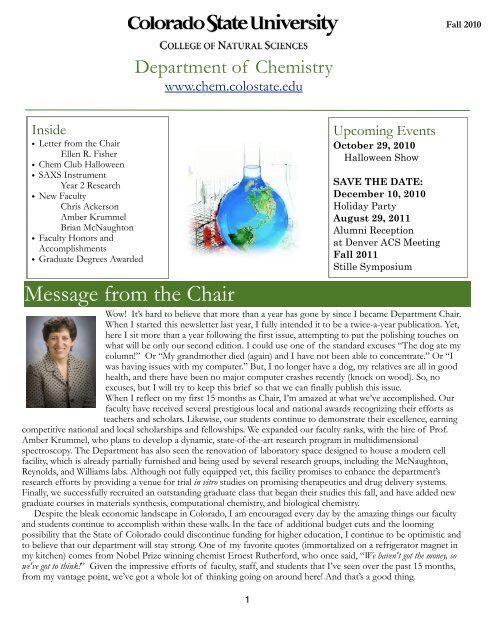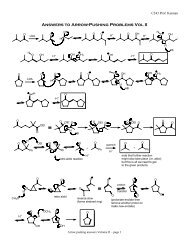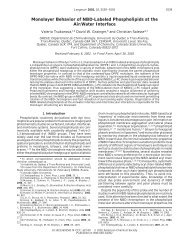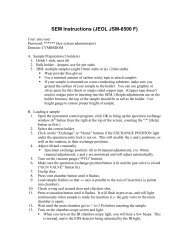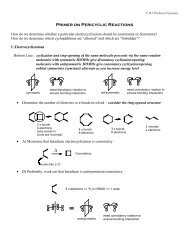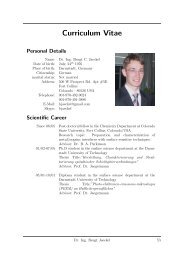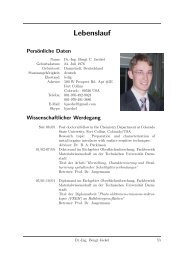Message from the Chair - Department of Chemistry - Colorado State ...
Message from the Chair - Department of Chemistry - Colorado State ...
Message from the Chair - Department of Chemistry - Colorado State ...
Create successful ePaper yourself
Turn your PDF publications into a flip-book with our unique Google optimized e-Paper software.
Fall 2010<br />
<strong>Department</strong> <strong>of</strong> <strong>Chemistry</strong><br />
www.chem.colostate.edu<br />
Inside<br />
• Letter <strong>from</strong> <strong>the</strong> <strong>Chair</strong><br />
Ellen R. Fisher<br />
• Chem Club Halloween<br />
• SAXS Instrument<br />
Year 2 Research<br />
• New Faculty<br />
Chris Ackerson<br />
Amber Krummel<br />
Brian McNaughton<br />
• Faculty Honors and<br />
Accomplishments<br />
• Graduate Degrees Awarded<br />
<strong>Message</strong> <strong>from</strong> <strong>the</strong> <strong>Chair</strong><br />
1<br />
Upcoming Events<br />
October 29, 2010<br />
Halloween Show<br />
SAVE THE DATE:<br />
December 10, 2010<br />
Holiday Party<br />
August 29, 2011<br />
Alumni Reception<br />
at Denver ACS Meeting<br />
Fall 2011<br />
Stille Symposium<br />
Wow! It’s hard to believe that more than a year has gone by since I became <strong>Department</strong> <strong>Chair</strong>.<br />
When I started this newsletter last year, I fully intended it to be a twice-a-year publication. Yet,<br />
here I sit more than a year following <strong>the</strong> first issue, attempting to put <strong>the</strong> polishing touches on<br />
what will be only our second edition. I could use one <strong>of</strong> <strong>the</strong> standard excuses “The dog ate my<br />
column!” Or “My grandmo<strong>the</strong>r died (again) and I have not been able to concentrate.” Or “I<br />
was having issues with my computer.” But, I no longer have a dog, my relatives are all in good<br />
health, and <strong>the</strong>re have been no major computer crashes recently (knock on wood). So, no<br />
excuses, but I will try to keep this brief so that we can finally publish this issue.<br />
When I reflect on my first 15 months as <strong>Chair</strong>, I’m amazed at what we’ve accomplished. Our<br />
faculty have received several prestigious local and national awards recognizing <strong>the</strong>ir efforts as<br />
teachers and scholars. Likewise, our students continue to demonstrate <strong>the</strong>ir excellence, earning<br />
competitive national and local scholarships and fellowships. We expanded our faculty ranks, with <strong>the</strong> hire <strong>of</strong> Pr<strong>of</strong>.<br />
Amber Krummel, who plans to develop a dynamic, state-<strong>of</strong>-<strong>the</strong>-art research program in multidimensional<br />
spectroscopy. The <strong>Department</strong> has also seen <strong>the</strong> renovation <strong>of</strong> laboratory space designed to house a modern cell<br />
facility, which is already partially furnished and being used by several research groups, including <strong>the</strong> McNaughton,<br />
Reynolds, and Williams labs. Although not fully equipped yet, this facility promises to enhance <strong>the</strong> department’s<br />
research efforts by providing a venue for trial in vitro studies on promising <strong>the</strong>rapeutics and drug delivery systems.<br />
Finally, we successfully recruited an outstanding graduate class that began <strong>the</strong>ir studies this fall, and have added new<br />
graduate courses in materials syn<strong>the</strong>sis, computational chemistry, and biological chemistry.<br />
Despite <strong>the</strong> bleak economic landscape in <strong>Colorado</strong>, I am encouraged every day by <strong>the</strong> amazing things our faculty<br />
and students continue to accomplish within <strong>the</strong>se walls. In <strong>the</strong> face <strong>of</strong> additional budget cuts and <strong>the</strong> looming<br />
possibility that <strong>the</strong> <strong>State</strong> <strong>of</strong> <strong>Colorado</strong> could discontinue funding for higher education, I continue to be optimistic and<br />
to believe that our department will stay strong. One <strong>of</strong> my favorite quotes (immortalized on a refrigerator magnet in<br />
my kitchen) comes <strong>from</strong> Nobel Prize winning chemist Ernest Ru<strong>the</strong>rford, who once said, “We haven't got <strong>the</strong> money, so<br />
we've got to think!” Given <strong>the</strong> impressive efforts <strong>of</strong> faculty, staff, and students that I’ve seen over <strong>the</strong> past 15 months,<br />
<strong>from</strong> my vantage point, we’ve got a whole lot <strong>of</strong> thinking going on around here! And that’s a good thing.
Chem Club Mad Scientist Halloween<br />
Photos by chemistry grad student Jeffrey Shearer.<br />
The Halloween Show is October 29 <strong>from</strong> 6:30 - 9 pm in <strong>the</strong> <strong>Chemistry</strong> Building. The<br />
show will include several small demonstrations where kids can learn about science<br />
and get prizes and candy at <strong>the</strong> same time! We will also have several crafts, hands-on<br />
activities and one large show. Parents are welcome to bring children <strong>of</strong> any age.<br />
CSU’s <strong>Chemistry</strong> Ranks Among Top 50 Across Nation<br />
U.S. News and World Report has named <strong>the</strong> graduate program in <strong>the</strong> <strong>Department</strong> <strong>of</strong> <strong>Chemistry</strong> at <strong>Colorado</strong><br />
<strong>State</strong> University one <strong>of</strong> <strong>the</strong> top 50 programs in <strong>the</strong> country.<br />
The <strong>Chemistry</strong> <strong>Department</strong> at <strong>Colorado</strong> <strong>State</strong> University held its<br />
first alumni event at <strong>the</strong> National ACS meeting in San Francisco.<br />
The reception was held Sunday night, March 21st at <strong>the</strong><br />
Intercontinental Hotel.<br />
Look for additional alumni events at upcoming ACS meetings,<br />
including a reception at <strong>the</strong> Fall 2011 National ACS Meeting in Denver!<br />
2
Materials Research at CSU Becomes a Little More SAXS-Y<br />
Fall 2009, <strong>the</strong> Central Instrument Facility became home to yet ano<strong>the</strong>r state-<strong>of</strong>-<strong>the</strong>-art materials<br />
characterization instrument as a result <strong>of</strong> a recently awarded Major Research Instrumentation (MRI) grant<br />
<strong>from</strong> <strong>the</strong> National Science Foundation. The addition marks an important milestone for a large number <strong>of</strong><br />
regional research programs now<br />
focused on nanoscale materials<br />
design and fabrication, and<br />
solidifies CSU’s reputation as<br />
one <strong>of</strong> <strong>the</strong> regional leaders in<br />
m a t e r i a l s r e s e a r c h a n d<br />
characterization. The<br />
instrument, which integrates<br />
small angle and wide angle X-ray<br />
scattering capabilities (SAXS<br />
and WAXS), was custom built<br />
for CSU by Rigaku Americas<br />
Corporation and stands as one<br />
Fourth year graduate student Nicole Escude (Chen) sets up <strong>the</strong> SAXS instrument to<br />
analyze a polymer sample.<br />
3<br />
<strong>of</strong> <strong>the</strong> most advanced lab-scale<br />
scattering tools available. Over<br />
thirty engineers and scientists<br />
<strong>from</strong> academic institutions all over <strong>the</strong> region contributed to <strong>the</strong> proposal, each with unique and fascinating<br />
new science to be explored. The instrument is extremely versatile, allowing analysis <strong>of</strong> materials and processes<br />
such as solution phase protein folding, complex liquid crystal behavior, and transition kinetics in<br />
nanostructured polymer melts. “We will have researchers using <strong>the</strong> instrument to help develop materials for<br />
new organic solar cells, water filtration membranes, chemical and drug delivery, nanoparticle catalysts, joint<br />
replacement technologies, renewable polymer composites, artificial muscles, tissue growth scaffolds...and <strong>the</strong><br />
list goes on and on.” says Pr<strong>of</strong>essor Travis Bailey, <strong>the</strong> principle investigator on <strong>the</strong> NSF-MRI award and<br />
assistant pr<strong>of</strong>essor in <strong>the</strong> <strong>Department</strong>s <strong>of</strong> Chemical and Biological Engineering and <strong>Chemistry</strong>.<br />
The new small-angle X-ray scattering instrument operates by sending a highly focused and intense X-ray<br />
beam through a small sample <strong>of</strong> material to be investigated. Some fraction <strong>of</strong> <strong>the</strong> radiation passing through <strong>the</strong><br />
sample scatters <strong>from</strong> its original path, in a manner that is wholly dependent on <strong>the</strong> sample’s structure.<br />
The instrument <strong>the</strong>n captures <strong>the</strong> pattern formed by <strong>the</strong> scattered X-rays, <strong>from</strong> which researchers are<br />
able to reconstruct <strong>the</strong> details related to <strong>the</strong> material’s three-dimensional structure. Although X-ray scattering<br />
has been widely used to elucidate crystal structure for a long time, <strong>the</strong> SAXS instrument allows <strong>the</strong> probing <strong>of</strong><br />
structures with dimensions on <strong>the</strong> size scales in <strong>the</strong> 10s to 100s <strong>of</strong> nanometers, ra<strong>the</strong>r than <strong>the</strong> 10s <strong>of</strong><br />
angstroms (i.e. <strong>the</strong> length <strong>of</strong> several chemical bonds) associated with classic X-ray diffraction. Ironically, many<br />
nano-structured materials are on a size scale that is just too big for o<strong>the</strong>r diffraction instruments to accurately<br />
elucidate structural characteristics.<br />
Pr<strong>of</strong>essor Bailey compares <strong>the</strong> issue to looking at <strong>the</strong> skyscrapers in <strong>the</strong> Denver skyline, with a<br />
telescope that is so powerful you can only see a few bricks at a time. “The new instrument will allow us to not<br />
only see <strong>the</strong> bricks, but to zoom out and see how <strong>the</strong> windows and floors are arranged as well. In fact we may be<br />
able to see <strong>the</strong> next building over, too.” It’s this incredible range over which <strong>the</strong> new instrument operates, <strong>from</strong><br />
several angstroms to hundreds <strong>of</strong> nanometers, that makes it such a valuable addition to materials researchers in<br />
our area.<br />
Students in <strong>the</strong> Bailey, Chen and Reynolds groups have been collecting data for multiple publications<br />
and use <strong>of</strong> <strong>the</strong> SAXS by researchers in CSU Engineering departments along with researchers at o<strong>the</strong>r<br />
institutions continues to grow.
The department welcomes...<br />
The department welcomes.....<br />
Dr. Chris Ackerson (Fall 2009)<br />
Dr. Ackerson joined <strong>the</strong> faculty <strong>of</strong> CSU’s chemistry department in <strong>the</strong> Fall <strong>of</strong> 2009.<br />
His research is focused at <strong>the</strong> interface <strong>of</strong> inorganic nanoparticle chemistry and biology. To<br />
this end, his research group endeavors to both make nanoparticles that can effect or reveal<br />
biological processes, especially disease processes, as well as harness biological processes to<br />
syn<strong>the</strong>size novel inorganic clusters and nanoparticles. The group currently comprises one<br />
postdoc, one graduate student and one technician. In addition to starting <strong>the</strong> lab, Dr. Ackerson<br />
teaches Inorganic Syn<strong>the</strong>sis and is active on <strong>the</strong> Graduate Admissions Committee. Dr.<br />
Ackerson was born in Boulder, <strong>Colorado</strong>, grew up in Stillwater, Oklahoma, and earned a<br />
bachelor’s degree with honors at <strong>the</strong> University <strong>of</strong> Texas–Austin where he completed a Special<br />
Honors Thesis in <strong>Chemistry</strong> under <strong>the</strong> supervision <strong>of</strong> Tom Kodadek. He pursued PhD studies<br />
at Stanford University under Roger Kornberg, <strong>the</strong> 2006 Nobel Laureate in <strong>Chemistry</strong>, where he<br />
developed new gold cluster syn<strong>the</strong>tic strategies for application to biological electron<br />
microscopy. Immediately prior to joining <strong>the</strong> faculty at CSU, Dr. Ackerson worked as a postdoc<br />
in <strong>the</strong> lab <strong>of</strong> CSU <strong>Chemistry</strong> alumnus Pr<strong>of</strong>essor Dan Feldheim, at <strong>the</strong> University <strong>of</strong> <strong>Colorado</strong><br />
in Boulder, where he worked on genetically encodable nanoparticles.<br />
Dr. Brian McNaughton (Fall 2009)<br />
Dr. McNaughton joined <strong>the</strong> <strong>Chemistry</strong> <strong>Department</strong> at CSU in <strong>the</strong> fall <strong>of</strong> 2009, and<br />
currently oversees a lab <strong>of</strong> seven postdoctoral, graduate, and undergraduate researchers. Research<br />
efforts in <strong>the</strong> McNaughton group are multidisciplinary, but focus on small molecule-dependent<br />
regulation <strong>of</strong> RNA biochemistry; inhibition <strong>of</strong> protein-protein interactions; targeted delivery <strong>of</strong><br />
<strong>the</strong>rapeutic and bio-imaging reagents; and novel biopolymer chemistry. Members <strong>of</strong> <strong>the</strong><br />
McNaughton group address <strong>the</strong>se challenges using methods in organic syn<strong>the</strong>sis, combinatorial<br />
chemistry, molecular biology, and cell biology, in <strong>the</strong> context <strong>of</strong> high-throughput screening and<br />
evolution-based selections. Brian received his Ph.D. <strong>from</strong> <strong>the</strong> University <strong>of</strong> Rochester under <strong>the</strong><br />
direction <strong>of</strong> Benjamin Miller, where he worked on methods for small molecule evolution and small<br />
molecule - RNA interactions. He <strong>the</strong>n conducted postdoctoral research as a Howard Hughes<br />
Medical Institute fellow at Harvard University, where he worked on protein engineering under <strong>the</strong><br />
direction <strong>of</strong> David Liu. Shortly after arriving to CSU Brian received a CDMRP New Investigator<br />
Award <strong>from</strong> <strong>the</strong> <strong>Department</strong> <strong>of</strong> Defense.<br />
Dr. Amber Krummel (Fall 2010)<br />
Dr. Krummel, who is originally <strong>from</strong> <strong>the</strong> Northwest, completed her Bachelor’s in<br />
<strong>Chemistry</strong> at Portland <strong>State</strong> University in Portland, Oregon. Dr. Krummel <strong>the</strong>n moved to<br />
Madison, WI to pursue graduate studies at <strong>the</strong> University <strong>of</strong> Wisconsin—Madison. Dr.<br />
Krummel earned her Ph.D. in Physical <strong>Chemistry</strong> under <strong>the</strong> guidance <strong>of</strong> Pr<strong>of</strong>. Martin Zanni.<br />
Her graduate work focused on developing 2D IR spectroscopy as a tool for investigating <strong>the</strong><br />
structure and dynamics <strong>of</strong> DNA. Upon completing her Ph.D., Dr. Krummel moved to<br />
Cambridge, Massachusetts, where she worked as a Postdoctoral Fellow in <strong>the</strong> Weitz lab at<br />
Harvard University. In July 2010, Dr. Krummel relocated to Fort Collins to join <strong>the</strong> <strong>Chemistry</strong><br />
Faculty at <strong>Colorado</strong> <strong>State</strong> University. Research in Dr. Krummel’s lab will focus on elucidating<br />
<strong>the</strong> molecular level details that drive nano- to microscopic properties in condensed phase<br />
systems. Initially, our group will exploit <strong>the</strong> structural and temporal resolution <strong>of</strong> twodimensional<br />
infrared spectroscopy to address questions related to pore-formation in lipid<br />
membranes, charge transport in polyelectrolyte membranes, and <strong>the</strong> nano-aggregation process<br />
<strong>of</strong> asphaltenes.<br />
4
Going with <strong>the</strong> Flow...Micr<strong>of</strong>luidics in <strong>the</strong> Henry Group<br />
Pr<strong>of</strong>essor Charles Henry’s group is on <strong>the</strong> move and in <strong>the</strong> groove. Literally. The Henry group (http://<br />
www.chem.colostate.edu/cshenry/Henry_Group/Home.html) develops micr<strong>of</strong>luidic devices and separation<br />
chemistry using micr<strong>of</strong>luidic technology, also known as “lab-on-a-chip”, to study environmental and<br />
bioanalytical systems. This hot new area <strong>of</strong> chemistry has attracted significant attention because <strong>of</strong> <strong>the</strong> potential<br />
for enormous improvement in biosensors for water remediation, electrochemical sensors for pharmaceutical<br />
applications, and in development <strong>of</strong> alternative bi<strong>of</strong>uels. Dr. Henry has also created a new startup company,<br />
Advanced MicroLAbs, Inc., which is currently working with a range <strong>of</strong> CSU researchers to develop many <strong>of</strong><br />
<strong>the</strong>se micr<strong>of</strong>luidics-based technologies into commercial products. Over <strong>the</strong> past year or so, Dr. Henry and his<br />
group have received considerable recognition for <strong>the</strong>ir efforts, including:<br />
• Dr. Charles Henry was awarded a prestigious US Scholars<br />
Fellowship <strong>from</strong> <strong>the</strong> Fulbright Foundation to conduct research for a<br />
semester at Chulalongkorn University in Bangkok, Thailand. The<br />
fellowship was hosted by <strong>the</strong> Thailand-U.S. Education Foundation<br />
(TUSEF) in Bangkok. While <strong>the</strong>re, Dr. Henry worked on a project<br />
to develop sensors based on ordinary filter paper. The sensors are<br />
very inexpensive, costing approximately $10Baht ($0.30) to make and<br />
are designed to ultimately be read by an inexpensive handheld<br />
instrument in <strong>the</strong> field. Tests for both environmental pollutants and<br />
disease biomarkers were developed as part <strong>of</strong> <strong>the</strong> project with a<br />
paper recently published in Analytical <strong>Chemistry</strong>. In addition to research,<br />
Dr. Henry taught a course in Micr<strong>of</strong>luidics for graduate students at<br />
Chulalongkorn University and spent his time visiting o<strong>the</strong>r universities<br />
and giving a number <strong>of</strong> lectures on a variety <strong>of</strong> research topics.<br />
Pr<strong>of</strong>essor Charles Henry,<br />
Dr. Carlos Gonzalez,<br />
Megan Easterly and Scott Noblitt<br />
• Dr. Carlos Gonzalez was awarded an Oak Ridge Institute for Science and Education post-doctoral<br />
fellowship to conduct research at CSU for <strong>the</strong> US Army Corps <strong>of</strong> Engineers. Dr. Gonzalez is co-advised by<br />
<strong>of</strong> Drs. Charles Henry (CSU) and Donald Cropek (Army Corps) and conducts research in development <strong>of</strong><br />
electrochemical biosensors as sensing elements looking at cellular responses to waterborne toxins in a multiinstitutional<br />
research project. He received his B.S. degree in <strong>Chemistry</strong> <strong>from</strong> Chapman University in 2001<br />
and his Ph.D. in <strong>Chemistry</strong> <strong>from</strong> Oregon <strong>State</strong> University in 2007.<br />
• Chuck Henry had a 2009 article named as <strong>the</strong> “Hot Article” by <strong>the</strong> Analyst which is a journal focusing on<br />
new science work <strong>of</strong> <strong>the</strong> highest quality, covering <strong>the</strong> areas <strong>of</strong> analytical, bioanalytical and detection science.<br />
Hot Articles are ones that have been rated "significant" by peer-reviewers.<br />
• Megan Easterly, a grad student in <strong>the</strong> Henry group obtained her B.S. in <strong>Chemistry</strong> at Harding University<br />
in Arkansas and is currently working toward her Ph.D in analytical chemistry. Megan was awarded a<br />
National Science Foundation grant to work on a GK-12 project, which is a collaboration between <strong>the</strong><br />
Biomedical Sciences, Computer Science, <strong>Chemistry</strong>, Electrochemical Engineering, and Ma<strong>the</strong>matics<br />
departments. The work focuses on fabricating a biosensor that can detect concentration gradients <strong>of</strong><br />
biologically relevant compounds in <strong>the</strong> brain and o<strong>the</strong>r tissues. Currently her research has centered on<br />
fabricating gold electrode arrays. These fabricated arrays are <strong>the</strong>n electrochemically tested and <strong>the</strong>ir<br />
responses calibrated according to varying concentrations <strong>of</strong> a model analyte. In addition to research, <strong>the</strong><br />
GK-12 project involves visiting high schools and enhancing student/teacher learning by providing real<br />
world scientific applications to <strong>the</strong> things <strong>the</strong>y are learning about in <strong>the</strong> classrooms.<br />
5
• Scott Noblitt, a senior grad student in <strong>the</strong> Henry group did his undergraduate work at Rose-Hulman Institute<br />
<strong>of</strong> Technology. He was awarded a Science to Achieve Results (STAR) fellowship <strong>from</strong> <strong>the</strong> US EPA beginning<br />
in January 2009. STAR fellowships are highly competitive with less than 5% <strong>of</strong> applicants receiving funding.<br />
The fellowship provides both tuition and a stipend for up to three years. Scott’s research project focuses on<br />
<strong>the</strong> development <strong>of</strong> an instrument for routine atmospheric aerosol chemical speciation using lab-on-a-chip<br />
technology. Atmospheric aerosols represent a major unknown in developing a fundamental understanding <strong>of</strong><br />
<strong>the</strong> impacts <strong>of</strong> human activity on <strong>the</strong> atmosphere.<br />
Faculty Honors and Accomplishments<br />
Our faculty have been recognized in many ways. Recent highlights <strong>from</strong> members <strong>of</strong> <strong>the</strong> <strong>Chemistry</strong><br />
<strong>Department</strong> include <strong>the</strong> following:<br />
Pr<strong>of</strong>essor Amy Prieto received a prestigious NSF Career Award with a proposal entitled “Energy Storage and<br />
Conversion - Coupling <strong>the</strong> Direct Electrodeposition <strong>of</strong> Crystalline Intermetallics with Targeted Outreach to<br />
Elementary Schools”. Dr. Prieto hopes to use some <strong>of</strong> her NSF funds to focus on adding renewable energy topics<br />
(in <strong>the</strong> context <strong>of</strong> transportation) to <strong>the</strong> popular Harry Potter based outreach shows <strong>the</strong> undergraduate <strong>Chemistry</strong><br />
Club at CSU has already developed.<br />
Pr<strong>of</strong>essor Brian McNaughton was honored with a New Investigator Award entitled “A Selection-Based<br />
Approach to Evolve Prostate Cancer-Selective Cell Penetrating Peptides: Application for Targeted Therapeutic<br />
Delivery and Imaging <strong>from</strong> <strong>the</strong> Prostate Cancer Research program <strong>of</strong> <strong>the</strong> <strong>Department</strong> <strong>of</strong> Defense.<br />
Pr<strong>of</strong>essor Yian Shi was <strong>the</strong> recipient <strong>of</strong> a Fellowship <strong>from</strong> <strong>the</strong> Japan Society for <strong>the</strong> Promotion <strong>of</strong> Science<br />
Fellowship.<br />
Pr<strong>of</strong>essor Melissa Reynolds received a grant <strong>from</strong> <strong>the</strong> Bioscience Discovery Evaluation Grant Program<br />
(BDEGP) – a state <strong>of</strong> <strong>Colorado</strong> HB1001 program through <strong>the</strong> <strong>State</strong> <strong>of</strong> <strong>Colorado</strong> Office <strong>of</strong> Economic Development<br />
and International Trade (OEDIT). Dr. Reynolds will use <strong>the</strong> funding to study <strong>the</strong> development <strong>of</strong> a universal<br />
biocompatible coating process for medical devices.<br />
In addition, <strong>the</strong> Boettcher Foundation named <strong>Colorado</strong> <strong>State</strong> University chemist Melissa Reynolds as one <strong>of</strong> only<br />
six 2010 Boettcher Investigators as part <strong>of</strong> <strong>the</strong> Webb-Waring Biomedical Research Program, which helps recruit,<br />
retain and advance scientific talent in <strong>Colorado</strong>. Reynolds is <strong>the</strong> only researcher <strong>from</strong> <strong>Colorado</strong> <strong>State</strong> University to<br />
receive <strong>the</strong> honor, which comes with a three-year, $200,000 grant.<br />
The 19th International Symposium on Fluorine <strong>Chemistry</strong>, co-organized by Steve Strauss, was held in Grand<br />
Teton National Park last summer. The conference was a smashing success with over 400 chemists and engineers in<br />
attendance.<br />
6
Faculty Honors and Accomplishments continued<br />
University Distinguished Pr<strong>of</strong>essor Bob Williams was appointed last year as <strong>the</strong> Co-<br />
Director <strong>of</strong> <strong>the</strong> Experimental Therapeutics groups in <strong>the</strong> Infectious Diseases and<br />
Cancer Superclusters. CSU Superclusters are groups <strong>of</strong> CSU researchers focused on<br />
crosscutting research areas <strong>of</strong> global importance (see http://superclusters.colostate.edu/ for<br />
more information on <strong>the</strong>se world-class programs).<br />
Also announced on August 30, Bob is <strong>the</strong> recipient <strong>of</strong> <strong>the</strong> 2011 ACS Ernest Guen<strong>the</strong>r<br />
Award in <strong>Chemistry</strong> <strong>of</strong> Natural Products. This is <strong>the</strong> highest award <strong>the</strong> ACS bestows for<br />
Natural Products research. The Ernest Guen<strong>the</strong>r Award is given to individuals who have<br />
accomplished outstanding work in analysis, structure elucidation, and chemical syn<strong>the</strong>ses <strong>of</strong><br />
natural products, with emphasis on independence <strong>of</strong> thought and originality.<br />
Lisa Dysleski received <strong>the</strong> College <strong>of</strong> Natural Sciences undergraduate teaching award.<br />
Pr<strong>of</strong>essor Ellen Fisher <strong>Colorado</strong> <strong>State</strong> University pr<strong>of</strong>essor and chair <strong>of</strong> <strong>the</strong> <strong>Department</strong> <strong>of</strong> <strong>Chemistry</strong>, has been<br />
recognized with <strong>the</strong> university’s Scholarship Impact Award, one <strong>of</strong> <strong>the</strong> highest annual honors given by <strong>the</strong><br />
university that includes $10,000 in funding to support her research.<br />
<strong>Chemistry</strong> by <strong>the</strong> Numbers<br />
The following list gives a snapshot <strong>of</strong> <strong>the</strong> chemistry department at CSU, by <strong>the</strong> number <strong>of</strong>:<br />
Current graduate students(Fall 2010)......................156<br />
International graduate students (Fall 2010)..............16<br />
Current undergraduate majors (Fall 2010).................167<br />
Female <strong>Chemistry</strong> majors (Fall 2010)........................89<br />
Freshman <strong>Chemistry</strong> majors (Fall 2010).....51<br />
Ph.D.’s granted 2009-2010........................14<br />
M.S. degrees granted 2009-2010................6<br />
B.S. degrees granted 2009-2010................23<br />
Full time research-active faculty (Fall 2010)...............29<br />
7
Graduate Degrees Awarded 2009-2010<br />
Doctor <strong>of</strong> Philosophy<br />
Tim Arthur (Summer 2010, Prieto)<br />
Atanu Bhattacharya (Spring 2010, Bernstein)<br />
Cameron Burnett (Spring 2010, Williams)<br />
Jie Hong (Spring 2010, Elliott)<br />
Xiangna Jia (Summer 2009, Williams)<br />
Dana Johnson (Spring 2010, Kennan)<br />
Igor Kuvychko (Summer 2009, Strauss)<br />
Qin Liu (Spring 2009, Rovis)<br />
Jennifer Moore (Spring 2009, Rovis)<br />
James Mosby (Summer 2010, Prieto)<br />
Brian Murphy (Spring 2009, Henry)<br />
Karl Stupic (Spring 2010, Meersmann)<br />
On Lo Wong (Fall 2009, Shi)<br />
Robert Yu (Spring 2009, Rovis)<br />
Masters<br />
Tashi Herzmark (Summer 2010, Elliott)<br />
Tina Ma (Fall 2009, Rappé)<br />
Lucas Mason (Fall 2009, Henry)<br />
Michelle Morgan (Fall 2009, Fisher)<br />
Brian Nettles (Fall 2009, Shi)<br />
Mark Oinen (Spring 2010, Rovis)<br />
Spring 2010 Commencement<br />
Honors grads: Amanda Ehlenbeck, Kristin Suhr,<br />
Dan Nelson, Ran (Nancy) Tao<br />
Front row (l to r): Amanda Ehlenbeck, Dustin Keller, Roy Miller, John Wydallis, Dan Nelson<br />
Second row (l to r): Kristin Suhr, Madison Martinez, Ran (Nancy) Tao, Travis Folsom, Julia Devine, Sheryl Johnson<br />
Back row (l to r): Branka Ladanyi, Grzegorz Szamel, Nancy Levinger, Ellen Fisher, Steve Strauss, Oren Anderson<br />
8


